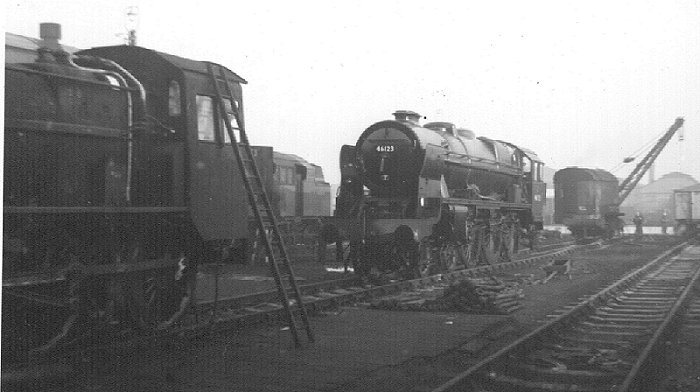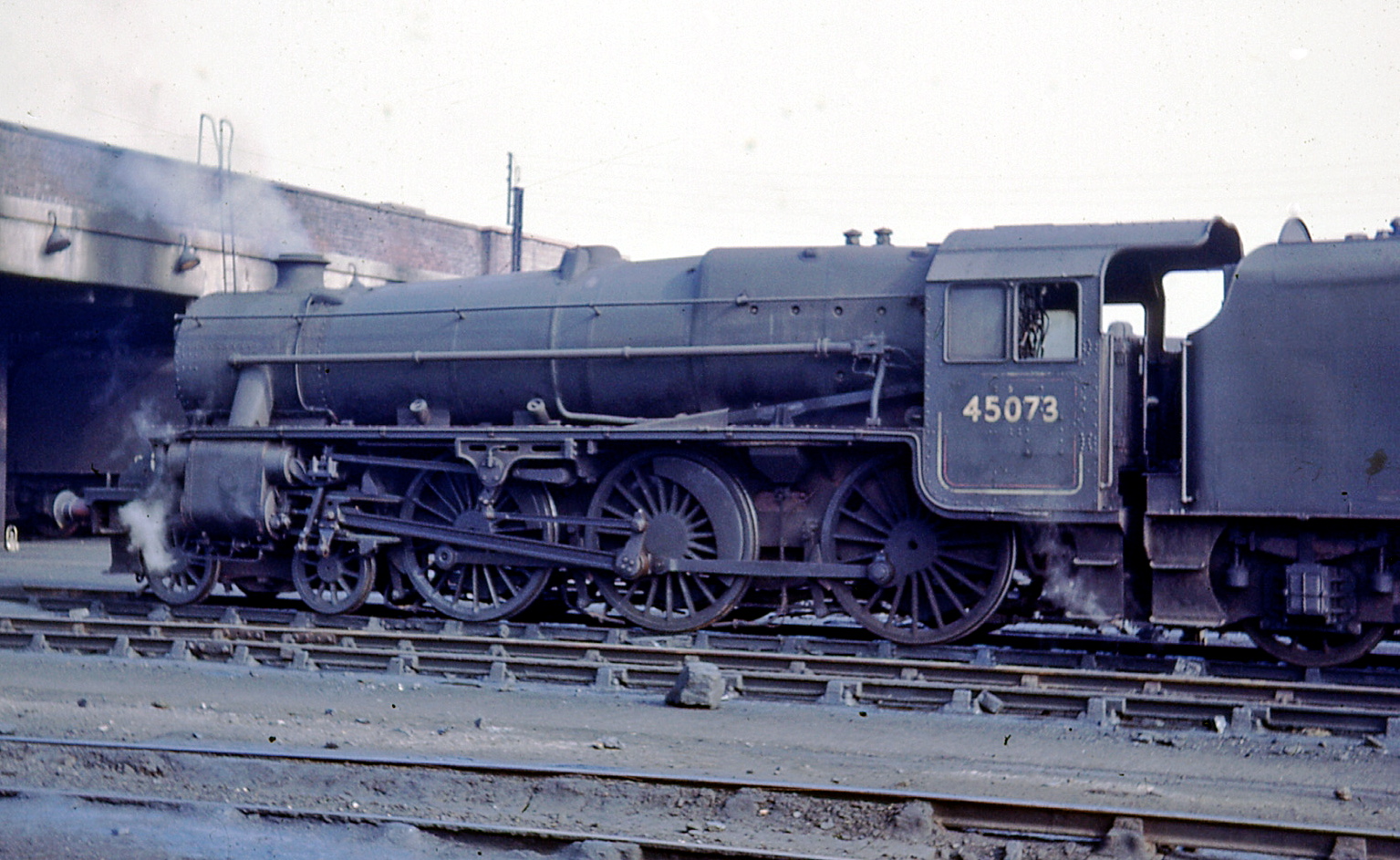|
LNWR Precedent Class
The London and North Western Railway Precedent Class was a class of seventy steam locomotives originally designed for express passenger work. History They were designed by F. W. Webb and built by the LNWR's Crewe Works between 1874 and 1882. The numbering was haphazard – while the first twenty carried "new" numbers in a solid block, the remaining fifty carried numbers formerly carried by withdrawn locomotives. All seventy carried names from new, and many of these had been used on withdrawn locomotives. Sixty-two of the locomotives were "renewed" (replaced with new locomotives carrying the same number and name) as Improved Precedent class locomotives between 1893 and 1901. The remaining eight were rebuilt as Improved Precedents in the 1890s; they retained their thick frames – the renewals had frames. Two of the unrenewed locomotives were scrapped in 1907, two in the 1910s, with four passing to the London Midland and Scottish Railway in 1923. They were allocated numbers ... [...More Info...] [...Related Items...] OR: [Wikipedia] [Google] [Baidu] |
Crewe Works
Crewe Works is a British railway engineering facility located in the town of Crewe, Cheshire. The works, which was originally opened by the Grand Junction Railway in 1840, employed around 7,000 to 8,000 workers at its peak. In the 1980s, a lot of the engineering works were closed. Much of the site has been redeveloped but the remaining parts are owned and operated by French-owned multinational rolling stock manufacturer, Alstom SA. During the late 19th century, the London and North Western Railway used Crewe Works to produce many famous locomotives such as the Webb Jumbo class and the compounds, the Whale Experiment and Precursor classes, and the Bowen-Cooke Claughtons. In particular, Whale's 1912 superheated G1 Class developed from a locomotive introduced by Webb in 1892, lasted, in many cases until 1964, near the end of steam in 1968. After grouping, the works were taken over by London, Midland and Scottish Railway which was the successor to the LNWR. It was during ... [...More Info...] [...Related Items...] OR: [Wikipedia] [Google] [Baidu] |
London And North Western Railway
The London and North Western Railway (LNWR, L&NWR) was a British railway company between 1846 and 1922. In the late 19th century, the L&NWR was the largest joint stock company in the United Kingdom. In 1923, it became a constituent of the London, Midland and Scottish (LMS) railway, and, in 1948, the London Midland Region of British Railways: the LNWR is effectively an ancestor of today's West Coast Main Line. History The company was formed on 16 July 1846 by the amalgamation of the Grand Junction Railway, London and Birmingham Railway and the Manchester and Birmingham Railway. This move was prompted, in part, by the Great Western Railway's plans for a railway north from Oxford to Birmingham. The company initially had a network of approximately , connecting London with Birmingham, Crewe, Chester, Liverpool and Manchester. The headquarters were at Euston railway station. As traffic increased, it was greatly expanded with the opening in 1849 of the Great Hall, designed by P ... [...More Info...] [...Related Items...] OR: [Wikipedia] [Google] [Baidu] |
LNWR Improved Precedent Class
The London and North Western Railway (LNWR) Improved Precedent Class or Renewed Precedent Class is a class of steam locomotives originally designed for express passenger work. They later gained the nickname of ''Jumbos''. History The locomotives were designed by F. W. Webb. A total of 158 were built in batches by Crewe Works 1887–1897 with two further additions in 1898 and 1901 respectively. They were officially "renewals" (i.e. replacements) of 96 Newton Class and 62 Precedent Class, so that, for accountancy purposes, they could be charged against the Revenue account rather than the Capital account of a "new" locomotive. On renewal, they kept the numbers and names of their predecessors, and as a result the numbering system continued to be completely haphazard. In addition, the eight Precedent class locomotives that were not renewed, were rebuilt to the Improved specification, but they retained their original thick frames, whereas the renewed locomotives had frames. On ... [...More Info...] [...Related Items...] OR: [Wikipedia] [Google] [Baidu] |
London Midland And Scottish Railway
The London, Midland and Scottish Railway (LMSIt has been argued that the initials LMSR should be used to be consistent with LNER, GWR and SR. The London, Midland and Scottish Railway's corporate image used LMS, and this is what is generally used in historical circles. The LMS occasionally also used the initials LM&SR. For consistency, this article uses the initials LMS.) was a British railway company. It was formed on 1 January 1923 under the Railways Act of 1921, which required the grouping of over 120 separate railways into four. The companies merged into the LMS included the London and North Western Railway, Midland Railway, the Lancashire and Yorkshire Railway (which had previously merged with the London and North Western Railway on 1 January 1922), several Scottish railway companies (including the Caledonian Railway), and numerous other, smaller ventures. Besides being the world's largest transport organisation, the company was also the largest commercial enterpri ... [...More Info...] [...Related Items...] OR: [Wikipedia] [Google] [Baidu] |
LMS Stanier Class 5 4-6-0
The London, Midland and Scottish Railway (LMS) Stanier Class 5 4-6-0, commonly known as the Black Five, is a class of steam locomotives. It was introduced by William Stanier and built between 1934 and 1951, of which 842 were built and were numbered 4658-5499 (BR then renumbered 44658-45499). Several members of the class survived to the last day of steam on British Railways in 1968, and eighteen are preserved. Origins The Black Five was a mixed-traffic locomotive, a "do-anything go-anywhere" type, designed by Stanier, who had previously been with the GWR. In his early LMS days, he designed his Stanier Mogul in which he experimented with the GWR school of thought on locomotive design. A number of details in this design he would never use again realising the superiority of details not used on the GWR. Stanier realised that there was a need for larger locomotives. These were to be the LMS version of the GWR Halls but not a copy, as the Hall was too wide to run most places in Br ... [...More Info...] [...Related Items...] OR: [Wikipedia] [Google] [Baidu] |
Ditton Junction Rail Crash
Ditton Junction is near Widnes on the Liverpool spur of the former London and North Western Railway. This complex junction had eight running lines and associated signal gantries. On 17 September 1912 the 17:30 Chester to Liverpool express was signalled to cross from the fast to the slow line, but the driver, Robert Hughes, age 41, from Llangwstenin, Conwy, who had little experience of the junction and had never been switched here before, misread the signals and thought he had a clear run through. The crossover had a speed limit of 15 mph but the train hit it at 60 mph. The locomotive, a of the Precedent class turned on its side and travelled some distance, striking the pier of an overbridge (partially demolishing it) and breaking in two. The six carriages following ploughed over the engine and were all destroyed - forming a heap of wreckage between the station platforms. Punctured gaslighting cylinders ignited, turning the scene into an inferno. The driver, fireman and 13 pa ... [...More Info...] [...Related Items...] OR: [Wikipedia] [Google] [Baidu] |
Ditton Railway Station
Ditton railway station, originally Ditton Junction, was a railway station which served the Ditton area of Widnes in Cheshire, England. It was located on Hale Road on the border between Ditton and Halebank. History The station opened in 1871 on the London-Liverpool line. It replaced an earlier station named Ditton Mill which was inconveniently located off the then new main line some 230 yards (210 m) to the east. On 17 September 1912, 15 people were killed when the 17:30 train from Chester derailed while crossing from the fast to the slow line at speed. The station was rebuilt between 1960-61 at a cost of £48,500 (). Ditton closed to passengers on 27 May 1994 and the station buildings were demolished in 2005. Paul Simon Ditton railway station is one of two stations where Paul Simon may have composed the song " Homeward Bound", the other being Widnes railway station. It is uncertain exactly where the song was written. In an interview with Paul Zollo for ''SongTalk'' Ma ... [...More Info...] [...Related Items...] OR: [Wikipedia] [Google] [Baidu] |
Fenny Stratford
Fenny Stratford is a constituent town of Milton Keynes, Buckinghamshire, England and in the Civil Parish of Bletchley and Fenny Stratford. Originally an independent town, it was included in the Milton Keynes " designated area" in 1967. From 1895 it formed an urban district with Bletchley, until 1974 when it became part of the (then) District of Milton Keynes. It is located at the southern edge of Milton Keynes, just east of Bletchley and west of the A5. Today A mixture of old buildings and new developments, Fenny Stratford is a small town on the edge of Milton Keynes. Its market may be long gone but it hosts various shops, restaurants, pubs, newsagents, and hotels centered mainly around Aylesbury Street. There is an LGBT friendly night club on Watling Street. Fenny Stratford railway station, one of the seven railway stations that serve the Milton Keynes urban area, is served by the (Bletchley - Bedford) Marston Vale Line. History The town name is an Old English language w ... [...More Info...] [...Related Items...] OR: [Wikipedia] [Google] [Baidu] |
London And North Western Railway Locomotives
London is the capital and largest city of England and the United Kingdom, with a population of just under 9 million. It stands on the River Thames in south-east England at the head of a estuary down to the North Sea, and has been a major settlement for two millennia. The City of London, its ancient core and financial centre, was founded by the Romans as ''Londinium'' and retains its medieval boundaries.See also: Independent city § National capitals The City of Westminster, to the west of the City of London, has for centuries hosted the national government and parliament. Since the 19th century, the name "London" has also referred to the metropolis around this core, historically split between the counties of Middlesex, Essex, Surrey, Kent, and Hertfordshire, which largely comprises Greater London, governed by the Greater London Authority.The Greater London Authority consists of the Mayor of London and the London Assembly. The London Mayor is distinguished from the Lord Mayo ... [...More Info...] [...Related Items...] OR: [Wikipedia] [Google] [Baidu] |
Railway Locomotives Introduced In 1874
Rail transport (also known as train transport) is a means of transport that transfers passengers and goods on wheeled vehicles running on rails, which are incorporated in tracks. In contrast to road transport, where the vehicles run on a prepared flat surface, rail vehicles (rolling stock) are directionally guided by the tracks on which they run. Tracks usually consist of steel rails, installed on sleepers (ties) set in ballast, on which the rolling stock, usually fitted with metal wheels, moves. Other variations are also possible, such as "slab track", in which the rails are fastened to a concrete foundation resting on a prepared subsurface. Rolling stock in a rail transport system generally encounters lower frictional resistance than rubber-tyred road vehicles, so passenger and freight cars (carriages and wagons) can be coupled into longer trains. The operation is carried out by a railway company, providing transport between train stations or freight customer facil ... [...More Info...] [...Related Items...] OR: [Wikipedia] [Google] [Baidu] |




